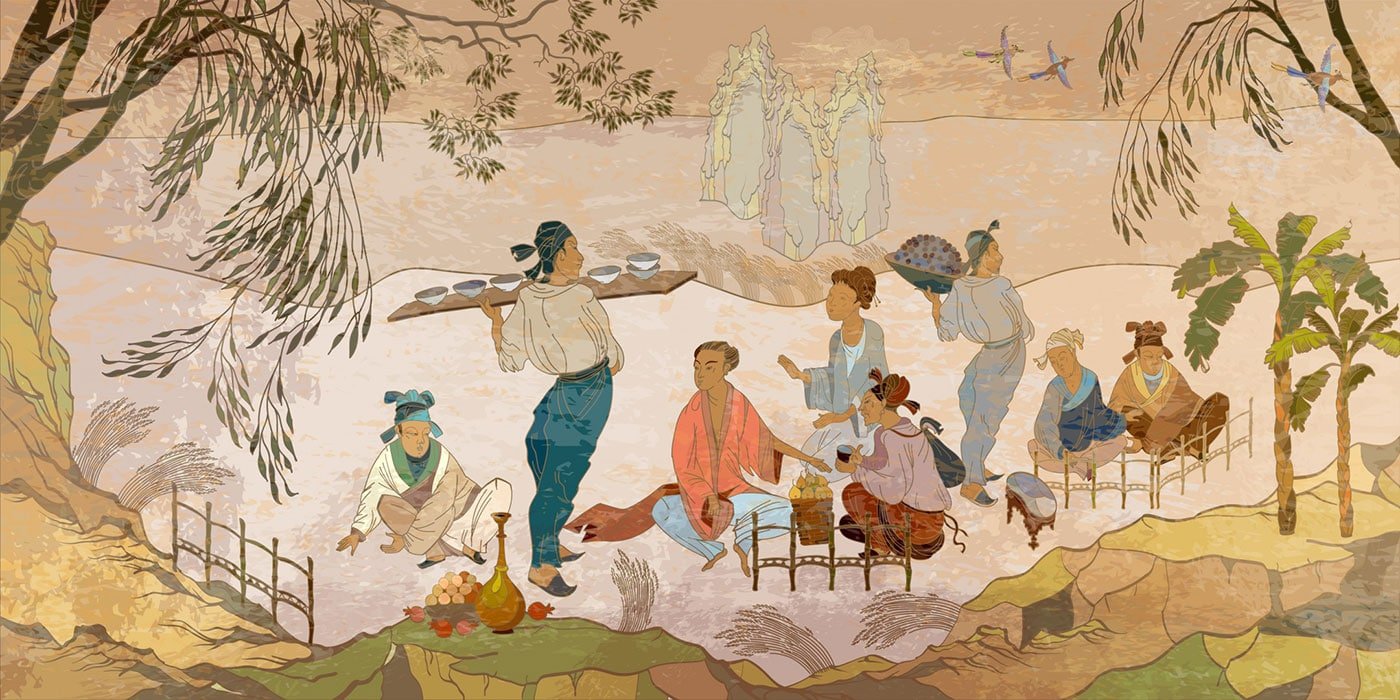
Table of Contents
The history of tea is as rich as its taste. Emperors, dynasties, myths and beliefs are intricately intertwined in it. Its place in Chinese cultural, medicine and social interactions cut across all levels of society.
There aren’t many beverages that transcend different spheres of life. Tea is one of the few. That it has survived many generations point to its significance. Indeed it’s a great story that has been retold countless times. Here, we will explore some of them.
In the beginning
A simple act of boiling water under a tree led to the discovery of the world’s leading beverage – tea. It was said in 2732 BC, Emperor Sheng Nung, leaves from a wild tree blew into the pot he was boiling water in. The pleasant aroma rising from the pot intrigued him.
The intrigue soon gave way to a bodily sensation he’s never had any prior experience with. Upon sipping it, a sense of warmth made its way to different parts of his body. One can imagine the flow and spread to be gentle yet awakening every part of the body it passes through.
He felt a strong need to explore and investigate the qualities of the beverage he just had. Ostensibly, this leads to the name ‘cha’an’, which literally means to investigate. As he dug further into it, the medicinal qualities of tea became more apparent. In today’s language, the infusion of the wild leaves into the pot of boiling water was a gamechanger.
From medicinal to everyday consumption occasions
Tea’s popularity rose rapidly in China as it moved from being consumed for its medicinal qualities to everyday consumption occasions. It became a staple beverage. Tea plantations were flourishing and in the process creating a new class of wealthy Chinese, namely, plantation owners and tea merchants.
In addition, two other factors fuelled its rapid growth. They are:
1. Tight control over the ritual of planting and harvesting of tea
To protect its status, royal decrees mandated the plantation and harvesting of tea. They may sound bizarre, but given its status in Chinese society then, it probably explains the socio-cultural role tea continues to play.
For example, only young men are allowed to handle tea heaves. This symbolises the purity of tea. To add, women involved in the trade aren’t allowed to eat garlic, onions or any spice with a strong after taste and aroma for fear it will contaminate the beautiful fragrance of tea.
The reverence showed to tea was as much symbolic as it was functional. After all, when it was discovered, there was no other foreign object present except for the pot of boiling water and wild leaves that had drifted into it.
2. Merchandising
This would be today’s language in cognizance of the popularity of tea as the royal seal it has. As tea plantation owners and merchants grew richer, their wealth and love for tea were accompanied by expensive and elegant tea wares to drink their tea from. These manifestations elevated the social status of tea in Chinese society and culture.
The spiritual dimension
Tea’s spiritual dimension can be attributed to the Zen school of Buddhism. An Indian prince had made a vow to meditate for 9 years and depriving himself of sleep to help him achieve this endeavour. Unfortunately, he failed. Upset by this failure, he cut off his eyelids and threw them on the ground. From them, tea leaves grew.
Myth or truth, tea’s spiritual dimension is strongly held by many. Its centricity in beliefs associated with Chinese culture, namely, Buddhism, Taoism and Confucianism, provides the basis of the latter. A Buddhist monk at the time of Emperor Tang’s rule wrote the Classic of Tea Treatise. In it, he details the types of tea, their preparation as well as benefits. Weaving prevailing thoughts in the aforementioned beliefs lend tea the spiritual dimension still in prevalence today.
Tea’s global reach
Tea went beyond China’s borders quickly, thanks to China’s global influence then. It was during the rule of the Sung Dynasty that was described as the Golden Age of tea. Wherever Chinese art, politics and beliefs landed, tea followed. It was this symbiotic relationship with Chinese culture that propelled tea’s global standing.
As global demand for tea rose, innovation ruled the day in its production and export. Originally, tea was green. But it was time-sensitive to an extent. To mitigate this problem tea growers invented a fermentation process that made tea less vulnerable to the time and distant it needs to travel to reach different parts of the world. Black tea was born.
The fermentation process preserved the fragrance and flavour of the tea. It was less sensitive than the original green tea. Certainly, this innovation is a pioneer, if not one of the pioneers, of processes designed to support the export market of any product. It was a catalyst to the growing global demand for tea.
Tea’s global growth did not dilute its place in its Motherland. In fact, it probably further cemented tea’s role in Chinese society and culture. This is evident today as overseas Chinese, both young and old, continue to honour the traditions and customs associated with tea in Chinese culture. And neither has tea’s sanctity been overwhelmed by pop-culture seen in other beverages, namely, coffee.
Big in Japan
In the early days of its history, outside of China and India, tea made an impact in Japan too. Again, tea’s entry into the latter was paved by a Buddhist monk named Saicho. While studying in China, he was introduced to tea. When he returned to Japan, he brought with him the seeds. Soon, tea plantations were sprouting all over the monasteries in Japan.
The “matcha” or green tea was born in Japan. It involves grinding the tea leaves using a stone mill. This produces a fine green powder. Whenever Japanese tea is mentioned, it is in reference to this fine green powder. That it was popularised by a Zen monk named Eisai is further evidence of the spiritual dimension of tea. And like in China, there are specific tea wares used in the preparation of Matcha although it may be less common now.
This far and further
From the Far East and North East, tea spread to the Middle East and eventually Europe. As global trade picked up, tea made its entry in these other regions and continents. In Marco Polo’s travel journals, for example, he stated his experience with tea in the East. Middle Eastern traders venturing into the Far East and North East talked bitter leaves in boiling water.
As global trade flourished with merchant traders travel to and back the different continents, so did tea. But tea’s presence in the West did not take root until the 17th century. It was a Portuguese missionary that facilitated this entry into the West. But Dutch traders and merchants took it to the next level, specifically, the Dutch East India Company.
It’s impossible to discuss the history of trade in the region without mentioning this company. It brought tea to Europe via ships and trains. From London, Paris to Amsterdam, tea was making its mark, especially, in the higher end of the social strata. This was partly due to its higher price.
Interestingly, the English did not take to tea as one would imagine they would have had. With High Tea perceived to be typically English, it’ll surprise many that tea took off much later, and that took amongst women. Until 1657, coffee was the preferred beverage amongst men. Then, the fist dedicated tea shop was opened by Thomas Garraway.
Tea received its royal seal, so to speak when Charles II married a Portuguese royal, Catherine of Braganza. As mentioned earlier, the Portuguese were amongst the first in the West to embrace tea. While this was an important milestone in the history of tea in the West, it was perhaps the forays of the British Eash India Company into the tea trade that was a more significant turning point.
The British East India Company was a close rival to the Dutch East India Company. Both were powerhouses in the economic and trade landscape in the East. In fact, the latter wielded significant political power and influence in the region on behalf of the British Empire. It created and managed trading posts in the region and gained a monopoly over the tea trade. This lasted over a century.
The Boston Tea Party
Any discussion on the history of tea is incomplete without referring to this party. What is it?
While tea was brought to America by the Dutch East India Company, it was only after the English captured what is now New York that popularised it. This paved the way for the British East India Company to impose its dominance in the tea trade like it did in the East.
Using its political influence, the company persuaded the English Parliament to impose heavy taxes, which proved to be a heavy burden on local tea merchants. They responded with a protest that saw dumping tea into the waters. This is the Boston Tea Party. It was a tense political climate that was followed by the American Revolution in 1776.
Although the company survived both upheavals, it eventually went under. The latter was a result of a campaign led by Richard Twinning and other tea merchants to expose the company’s wrongdoings. When the English government ended the company’s monopoly as a result of the campaign, the British East India Company collapsed.
Following the demise of the company, the tea trade flowed freely and directly between China and America. Using more modern ships, tea was shipped to America much faster than it has ever been. The best teas found their way into the world’s biggest consumer market.
Innovation
Tea became a mass consumer beverage in America. It was part of the American social narrative. With its presence firmly affixed on the American lifestyle, innovation in its preparation and consumption followed. Amongst the most prominent is iced tea. Unusually hot weather in St. Lois, Missouri led to the addition of ice to the beverage by a tea merchant at the 1904 World’s Fair. Today, ice tea makes up 80% of the total tea market in the US.
Apart from ice tea, another innovation that came out of America is tea bags. The person credited with this innovation is Thomas Sullivan. He was a tea merchant from New York. However, it must be said that he commercialised tea bags, not its invention. The patent for tea bags had been in existence at the turn of the 20th century.
Conclusion
From its accidental beginning in China, tea is today the Number 1 beverage in the world, water aside. Its rich story is in part due to its symbiotic relationship with Chinese culture. Neither has faded.






